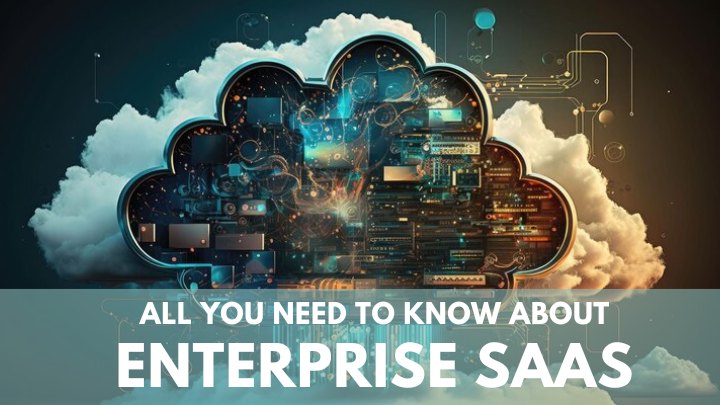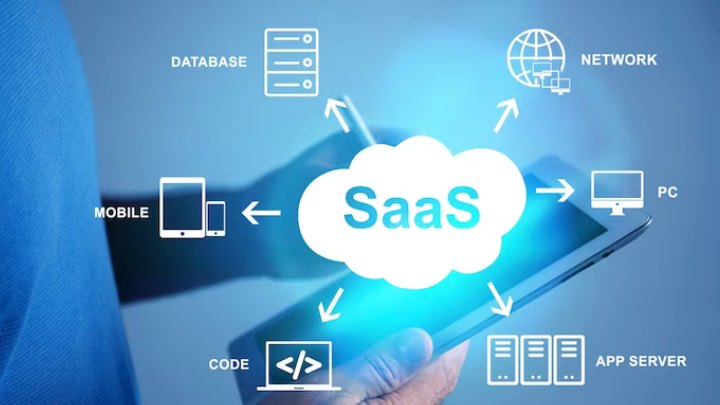
Full form of SaaS is Software as a Service.
Enterprise SaaS is a way for businesses to get applications from a third party vendor and use them online. It’s designed to be flexible for businesses, easy to set up, and cheaper overall. This means that businesses can focus on what they’re good at instead of worrying about IT and software upkeep. It also helps them reach more users and potential customers.
What is SaaS?
It is a a type of cloud computing. SaaS allows users to access software through the Internet. You don’t need to download or run on machine. Software applications are licenced, hosted, and kept up-to-date by the service provider in a SaaS environment. They are made accessible to users via subscription.
Customer relationship management (CRM) software, enterprise resource planning (ERP) systems, and other services which meet the demands of big businesses and organizations are typically referred to as “Enterprise SaaS.” Enterprise SaaS is, on average, more expensive but also offers more features than standard consumer-grade SaaS options.
Benefits of Enterprise SaaS
Enterprise SaaS’s cost-effectiveness is one of its main advantages. Customers’ total cost of ownership (TCO) is frequently lower with Enterprise SaaS because they don’t have to manage servers or pay licensing costs. Customers also don’t have to bother about software upgrades or patches because the software vendor takes care of those tasks.
Additionally, Enterprise SaaS enables users to access the software quickly and conveniently from any location. It is done using just a web browser. Last but not least, enterprise SaaS systems can easily and quickly adapt to changing customer needs because to their built-in scalability.
It also nullify the cost of hardware and software purchases. SaaS solutions enable businesses to handle seamless data management, enhanced flexibility, scalability, and security. You can start with no initial outlay and continuing expenses.
How Enterprise SaaS can benefit SEO Businesses?
Businesses engaged in search engine optimization (SEO) can take advantage of SaaS solutions’ s scalability. It helps to adapt to the changing needs of their customers. By doing this, you can avoid spending money on servers and software purchases and cut down on downtime when website traffic increases.
Wyoming SEO services offers organizations automated updates, access to tools, and statistics to track SEO success and failure.
What’s the difference between SaaS and PaaS?
Full form of PaaS is Platform as a Service.
The degree of customisation that is possible is the main distinction between SaaS and PaaS.
- Software-as-a-service, or SaaS, is a method of delivering software in which the seller gives customers online access to an application but restricts their ability to alter or customize it.
- PaaS, or platform as a service, on the other hand, is a cloud-based computing platform that gives the user more control over the software and its features. Customers can modify software applications with PaaS to suit their own requirements.
What types of Enterprise SaaS solutions are available?
Enterprise SaaS solutions come in many different varieties. These include
- Technologies for collaboration
- Marketing automation
- Enterprise resource planning (ERP)
- Data analytics
- Customer relationship management (CRM)
and more.

Web conferencing, chat apps, and remote data synchronization tools are just a few examples of the numerous cloud-based communication and collaboration solutions that are accessible.
There are many technologies accessible, as well as particular kinds of enterprise SaaS solutions. Healthcare organizations can use specialized solutions like electronic medical record (EMR) systems or e-prescribing programmes, for instance. Also, there are vertical enterprise SaaS solutions, which are created to address the unique requirements of a single industry, like accountancy or retail.
Deployment and management considerations for Enterprise SaaS Solutions
It’s important to take setup, deployment, and management costs into account when choosing an enterprise SaaS solution. Also, it’s critical to think about how the solution will be included into currently in use services and systems, as well as how user access will be controlled.
When money is an issue, using a SaaS platform over a conventional software package might be quite advantageous. Usually no upfront investments are required, and setup costs are considerably diminished. The software is hosted in the cloud, so there is often no need to buy hardware or pay for IT maintenance. Users just pay for the services they actually use, there are no installation or ongoing maintenance expenses for the programme.
Security and compliance for Enterprise SaaS Solutions
Security and compliance are key considerations when it comes to the adoption and maintenance of SaaS solutions. Increase your online visibility with Incrementors’ Enterprise SEO services. It offer a safe platform that complies with all applicable laws and regulations. It is crucial to confirm that the SaaS solution complies with industry standards when a company handles sensitive consumer data, such as financial or medical records. Businesses must ensure that their SaaS application complies with any industry rules that are relevant to their particular sector. Along with creating guidelines for managing data and access permissions, businesses must make sure compliance requirements are written into contracts with SaaS providers.

Challenges associated with implementing Enterprise SaaS Solutions
Integrating enterprise SaaS solutions with current systems is the most frequent issue that arises. Data is commonly held in numerous systems by many organizations, yet these systems frequently lack the essential APIs or other interoperability tools. Organizations also need to make sure that their data is secure given that it is being stored in the cloud rather than locally.
The long-term expenditures connected with an enterprise SaaS solution must also be taken into account because they could rise over time. SaaS solutions frequently offer tremendous scalability and flexibility, but as they expand, they may need to incur more costs. Due to the possibility that different organizations have varied requirements, compliance problems are also crucial to take into account. Finally, people must think about the assistance they receive and how soon.
Conclusion
Larger organizations like businesses, institutions of higher learning, and governmental agencies might benefit from enterprise SaaS, a sort of cloud computing. Compared to customary on-premises applications, the subscription-based service is more cost-effective. Additionally, it has many benefits for businesses, including increased scalability, flexibility, and availability.
It accelerates the pace at which organizations deploy applications. In the end, it enables businesses to use the most cutting-edge apps available without having to spend their own resources on software development and upkeep.
